ISLAMIC NATIONALISM AND THE MIDDLE EAST
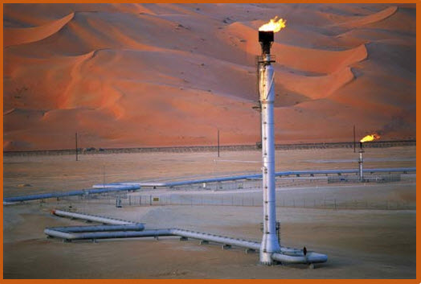
Oil Fields in the Middle East
Unit Overview
Driven
by a spirit of nationalism, the nations of the Middle East worked to move
beyond colonialism and to redefine themselves as modern nations.† Their leaders often modeled their efforts on
the governments of the West and promised major improvements.† When these pledges were unfulfilled,
countries turned to dictatorships or theocracies established by Islamic
reformers.† These, too, failed to provide
political stability.† Since the region
contained massive oil reserves, it was also impacted by foreign interference
and Cold War competition.† Letís see how
it all happened.

STOP:† Answer Section A Questions
Independence
and Islamic Revival
Following
World War I, the countries of the Middle East worked to free themselves from imperialism and their colonial
status.† Nationalism was the driving force of this movement.† Although many Arab and Persian territories
won their independence by 1945, they remained economically tied to the
West.† Americans and Western Europeans
continued to own the industries, to control the banking system and to provide
money for development.† Westerners also
promoted modernization.† This included the adoption of governments
based on western laws and the separation of religion from politics.† Arab leaders promised economic improvements
and greater social justice, but for many, life changed very little.
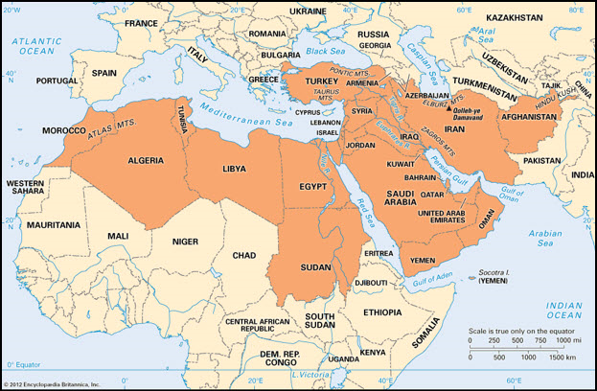
Map of
the Middle East
Since
their leaders failed to solve their problems, people became disillusioned and
blamed western influence for the lack of progress.† Some idealistic Arabs focused on Pan-Arabism, the concept of uniting all
Arabs in a single state.† It would
destroy Israel, challenge the West
and gain economic independence.†
Regional, ideological and
religious differences, however, made this an impractical dream.† By the 1970s, many Muslims began to demand a
return to the Sharia, or Islamic
law.† They argued that a reliance on
Islamic principles was the only way to bring about effective change.† The idea of an Islamic revival kicked off an
intense debate across the Muslim world between extremists and moderates.† Muslim reformers continued to demand that
political power be returned to religious leaders.† Some called for peaceful measures to
accomplish a new order; others were willing to engage in acts of terrorism to accomplish the goal.
STOP:† Answer Section B Questions
The
Islamic States and the Cold War
Both
the United States and the Soviet Union recognized the strategic value of the
Middle East.† The regionís enormous oil
reserves and key waterways caused the superpowers to compete for allies as part
of the Cold War.† For example, the United
States send aid to Turkey to prevent
a communist takeover in 1947.† It also supported
the shah of Iran due to his
anticommunist stance.† In some respects,
however, the Soviets had an advantage here.†

An Oil Rig in the Persian Gulf
The Arab
nations did not trust their former colonial rulers from Western Europe and
resented U.S. support for Israel.† Iraq, Syria and Libya became Soviet client states, a term used to designate
countries dependent on a stronger nation for financial and military
support.† Although Egypt declared itself a nonaligned country, it accepted millions of
dollars in aid from the Soviet Union.† In
the Arab-Israeli conflicts, the United States sold weapons to Israel while the
Soviet Union supplied the Arab states.†
As the Cold War ended, global concern focused on the development of
weapons of mass destruction in the Middle East.†
It was rumored that Israel possessed nuclear weapons.† At the same time, military experts believed
that Iraq was stockpiling chemical and biological armaments.† This added to the continuing unrest that
developed as a result of major changes in Iran in the late 1970s.
STOP:† Answer Section C Questions
Iranís
Revolution
The
nation of Iran traced its roots to the Persian Empire and became one of the
most ethnically diverse regions in the Middle East.† Although the majority of the population
consisted of Persian-speaking Iranians, many other groups also settled
here.† Islam was the countryís
predominant faith.† Unlike its neighbors,
most Iranians considered themselves Shiite
rather than Sunni Muslims.† The vast oil reserves of Iran attracted the
attention of the western powers.† They
supported Iranian leaders that best served their interests.† By 1945, Iranian nationalists, led by Muhammad Mosaddiq challenged this
practice.† They obtained enough votes
within the Iranian parliament to nationalize the countryís oil industry.† This set off a complex chain of events
involving Shah Muhammad Reza Pahlavi,
Britain and the United States.†
Consistent with its containment
policy, the U.S. wanted an anticommunist leader in Iran and assisted the
shah in removing Mosaddiq in 1953.† Most
Iranians resented this interference.†
However, the American government continued to back the shah with weapons
and advisers for the next twenty-five years due to his anticommunist stance.
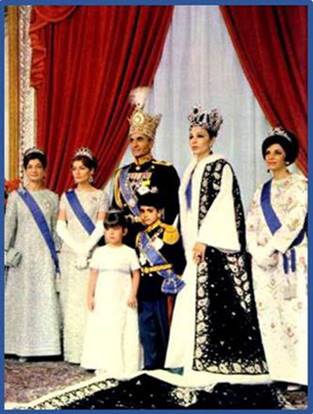
Shah Muhammad Reza Pahlavi and the
Royal Family
Even
though he had U.S. backing, Shah Pahlavi realized his position was
precarious. To calm the unrest and to gain respect for Iran within the
international community, he used oil profits to modernize the country.
Along with improved highways and bridges, Iran extended rights to women and
redistributed some land to peasants. Following the western model of the separation of church and state, the
shah eliminated government offices held by religious leaders. This did
not quiet the opposition.† The number of
protests increased. In many instances, those who opposed the shah were
arrested, tortured, executed or sent into exile.
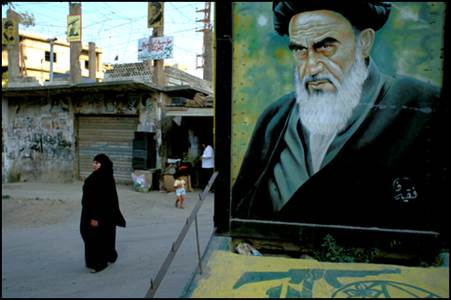
Mural of the
Ayatollah Khomeini in Beirut's Shiite district
The
harsh crackdown by the shah encouraged many Iranians to rally around Ruhollah Khomeini, an ayatollah, or Shiite Muslim legal
expert. He denounced the shahís regime as a violation of Muslim law and
spoke out against the negative effects of western influence. The shahís
fear increased as public demonstrations grew larger, and he fled the country in
1979. Religious leaders declared Iran an Islamic republic and established a theocracy, a form of government controlled by religious
authorities. The revolutionaries quickly made new laws to reform what
they labeled as corruption. For example, legislation that extended rights
to women was revoked, and all forms of western media, including books, movies
and music, were banned. When Shah Pahlavi was permitted to enter the
United States for medical treatment, militant Muslims seized the U.S. embassy
in the capital city of Teheran and
held fifty-two Americans hostage for over a year. The Ayatollah Khomeini
and his followers also encouraged other Islamic states to replace their
governments with theocracies.
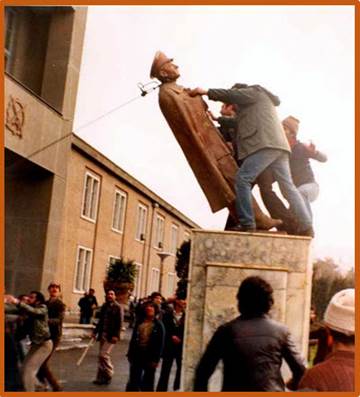
Protesters Tearing down a Statue of the Shah
Although
the revolution did not spread to other countries, the prospect frightened
Iranís neighbors. This was certainly true in Iraq where the Sunni leadership feared an uprising by an inspired
Shiite majority. Therefore, Saddam
Hussein, Iraqís dictator, invaded Iran in September of 1980. Although
both sides launched several final offensives, the bloody conflict dragged on
and resulted in thousands of military and civilian deaths. Both sides
finally accepted a United Nations ceasefire agreement in 1988. The end of
the Iran-Iraq War and the death of
the Ayatollah Khomeini in 1989 offered opportunities for more moderate views to
surface in Iran, but the election of 2005 awarded the presidency to Mahmoud Ahmadinejad, an extremely conservative Islamic hardliner. He
reaffirmed Iranís commitment to destroy Israel and refused to comply with a
United Nationís resolution demanding the suspension of the countryís nuclear
program.
STOP:† Answer Section D Questions
Wars
in the Persian Gulf
The
Iran-Iraq War did little to deter the ambitions of Saddam Hussein.
Because he argued that the region was actually part of Iraq, the dictator
ordered his troops to invade the oil-rich country of Kuwait in 1990. Along with increasing the number of oil
fields under Iraqi control, the conquest of Kuwait provided an opportunity for
the landlocked country to have access to the Persian Gulf. Americans
viewed the invasion as a threat to Saudi
Arabia, a strong U.S. ally in the Middle East, and as disruption to the
flow of oil. The United States, under the direction of President George H.W. Bush, formed a
military coalition that included
nations from Europe and the Arab world to force the Iraqis out of Kuwait.† †They
were successful. Although Saddam Hussein was defeated, he continued to
hold power in Iraq when the conflict ended in 1991.
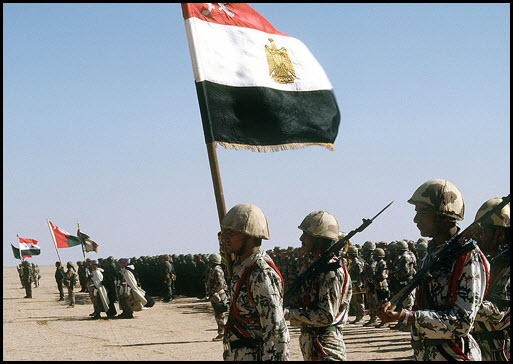
Coalition Troops from
Egypt, Syria, Oman, France and Kuwait
Saddamís
defeat in Kuwait inspired Shiite uprisings in southern Iraq against the
Sunni-led government.† These were
brutally crushed by the Iraqi military.†
At the same time, the Kurds,
an ethnic group in northern Iraq, rebelled.†
Saddam responded by ordering the use of chemical weapons.† The United Nations intervened and established
no-fly zones to protect the Kurds
and Shiites from aerial attacks.† Because
Saddam had used profits from the sale of oil to buy armaments abroad, a number
of sanctions were placed on Iraq to
curtail this practice.† The U.N. also
ordered the country to stop manufacturing chemical weapons.† Iraq, however, frequently ignored the no-fly
zones and denied access to U.N. inspectors.†
Pressure from the international community along with American and
British airstrikes eventually convinced Saddam to admit the weapons inspectors
in 2003.
The
United States and Great Britain were adamant that the Iraqis possessed weapons
of mass destructions and intended to deploy them.† President George W. Bush also accused Iraq of
harboring organizations that led to terrorist attacks on the U.S. in 2001.† Although they had no backing from the United
Nations, President Bush and British Prime Minister Tony Blair planned an invasion of Iraq in 2003.† This led to the occupation of Iraq and the
capture of Saddam Hussein, who was tried and executed for crimes against
humanity.† Although Iraqis viewed the
demise of Saddam as a positive outcome of the invasion, many resented this intervention.† Therefore, British and American troops
continually confronted guerrilla attacks and resistance fighters when the
large-scale battles ended.† Peacekeeping
forces worked to restore order, but building a new government was a complex
task for the Iraqi people.† Because most
of the countryís citizens have only lived under dictatorships, there was almost
no experience with representative government.†
Religious differences and ethnic nationalism have made collaboration and
compromise difficult.
What
Does It All Mean?
Shaped
by a history of colonialism and Cold War competition, the Middle East continues
to be conflicted by a variety of forces.†
Religious differences, nationalism and opposing goals are all issues
with the potential to spark unrest and violence.† The regionís large oil reserves guarantee the
intervention of foreign powers, but environmentalists warn that competition for
water resources is likely to be a source of controversy in the near
future.† At the same time, terrorism
represents a serious threat throughout the Middle East.† Groups such as al-Qaida and Islamic State of
Iraq and Syria (ISIS) have limited the possibility for peace and
stability.† Meanwhile, other regions of
the world experienced dramatic changes as well. †The nations of Africa also emerged from their
colonial past.† New governments were
challenged by civil wars, economic hardships and struggles for civil rights.

Additional Resources and Activities
After Thirty Years of War, Young People Leave Iraq: †Article and Quiz
After Thirty Years of War, Young People Leave Iraq:† Writing Exercise